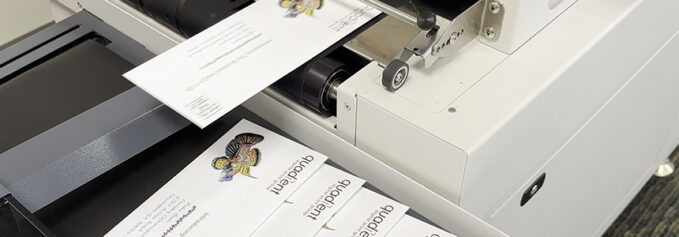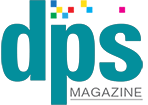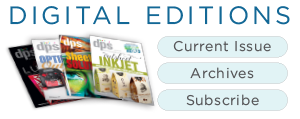
by Melissa Donovan
Envelope printers are advantageous to any size print environment. There is a solution for every envelope printing need, whether it is at the industrial level to something designed for one-off stationary requests. Advancements in inkjet, workflow automation, and finishing components influence popularity, especially in the last decade or so.
Above: A close up of printed envelopes from the Quadient MACH 9DS.
“Digital printing to envelopes has come a long way in the last 15 years, yet we have only seen the new generation of printers take performance leaps up to near production-level speed with excellent output quality and durability in the last few years. These are exciting times to be in the industry,” admits William Longua, senior director, digital print group, Quadient.
Classification of Printers
Due to the sheer scale of options, envelope printers are categorized by a number of factors, for example desktop versus industrial, inline versus online, or a function of the press itself—entry-, mid-, or high-volume printing.
Andy Bruce, product manager – inserter and digital solutions, BlueCrest, lists key factors like color capability (CMYK or monochrome), print resolution, print speed, cost per thousand, and the type of substrates or materials the press supports.
“These segments help differentiate printers based on functionality, performance, and cost efficiency to meet specific pricing needs,” explains Bruce.
Certainly, how envelope printers are categorized can also depend on the manufacturer. For example, Quadient classifies its products into two main segments—commercial and production; and then breaks them down into entry-, mid-, and high-volume presses.
Entry level, based on Quadient’s product line, includes mail centers, print shops, and marketers of all sizes looking to achieve around 7,500 envelopes an hour, like its MACH 5 color printer. Mid volume, the MACH 7 is designed for printing up to 10,000 envelopes per hour or commercial printers looking to print 50,000 envelopes per month or more. Finally, high-volume speeds are illustrated by its MACH 9DS, for those printing up to 1,000,000 pieces per month.
Digital’s Evolution
The past five to ten years, we have witnessed digital printing’s increased role in envelope decoration.
“The resurgence of direct mail, combined with automation, has positioned digital envelope printing as essential for modern marketing campaigns. Affordable equipment and trade-in programs have further made these solutions accessible to businesses of all sizes, allowing them to create impactful, customized communications efficiently,” note Bill Frederick, director of sales and Tim Murphy, president, Printware LLC.
Jesse Heindl, marketing manager, RISO, Inc., says the economy is creating a boost in interest for cutsheet production inkjet in general. “Wages, labor, and paper have all gone up in cost, with the end user bearing the brunt of those increases. They have cut their jobs in half to protect budgetary requirements. The number of jobs to the print shop have doubled but all for the same volume—or less,” continues Heindl.
For example, what used to be a job of 100,000 envelopes is now two jobs of 50,000, printed months apart. “That makes for a world of short-run jobs, where the new requirement is smaller production engines, but more of them in order to print multiple jobs simultaneously. That is the new production formula, and mid-size inkjet units with the ability to print envelopes are perfect in that type of workflow,” suggests Heindl.
“Over the past decade, the cost per thousand prints, including both CAPEX and operating expenses, has dropped. This decline has made it possible to integrate printing directly into non-print work cells, streamlining workflows, consolidating work cells, reducing costs, and boosting efficiency,” agrees Bruce.
The ability to print variable data addresses along with personalized marketing messages on the face of the envelope is big for municipalities and school district in-plants. “Print buyers are coming around to the reality that envelopes are disposable pieces and refuse to spend big dollars on them. One of the improvements we made over the last five to ten years was the clarity with which barcodes could be printed and more easily scanned, which makes a huge difference to the USPS,” explains Heindl.
Productive Advancements
Advancements in inkjet technology, workflow solutions, and automation are in demand for envelope printers.
“Improvements to inkjet allow for much faster printing with higher contrast color and more durable inks, which are also more affordable,” says Longua.
“Advancements in inkjet technology drive demand for versatile, high-resolution printing solutions. These advancements also encourage seamless workflow integration and automation, ensuring higher efficiency, scalability, and reduced manual intervention,” explains Bruce.
“We see a big surge in inkjet for high-volume mailing, and the reason usually cited is the increase in uptime. High-speed printing lets print shops burn through long runs quickly, and our heatless imaging process means that they experience fewer breakdowns, fewer service calls, and more time printing and meeting their service level agreements. Improvements in workflow also streamline the printing process and reduce a lot of the labor involved for running specific jobs,” admits Heindl.
Frederick and Murphy provide examples of workflow and automation advancements like auto-loaders, streamlined software integration, and reduced manual handling. “These further boost demand by increasing efficiency, reducing production times, and enabling seamless integration into existing print and mail workflows.”
Configuration Considerations
Digital envelope printing can be performed inline, offline, or near line.
Inline
Printing and finishing inline offers a host of benefits, but also has its challenges.
With printing and finishing inline, everything is streamlined. “The advantages of inline envelope printing include streamlined workflows with fewer touch points, resulting in greater efficiency and the potential for a reduced headcount.
Additionally, the system enables faster and more effective quality control, which contributes to accelerated production times, ensuring a smoother overall operation,” says Bruce.
Longua agrees, citing fewer touch points or faster setup time as key to eliminating the need for highly skilled labor to operate more complex equipment, which saves in cost and time.
Hurdles to overcome include what Bruce refers to as “reduced flexibility and increased complexity” since the entire process is inline. This means offering additional training or adjusting existing processes. He also says that inline systems require a higher initial investment, which poses a barrier to adoption.
Longua also sees challenges related to substrate availability and compatibility. “This is depending on the printing technology chosen, but new media options are appearing all the time that address this.”
“Challenges include ensuring consistent print quality on various envelope stocks and managing feeding mechanisms to handle diverse sizes and materials without jams or misalignments,” admit Frederick and Murphy.
Offline and Near Line
Alternatively, an envelope printer can stand on its own, with finishing near or offline configurations.
A standalone envelope printer offers cost savings on printing and inventory requirements. “Direct printing eliminates the need for a warehouse to store racks of printed envelopes. It also enables variable data and graphics printing at the same time. A print provider can service hundreds of customers with a lower investment in physical space and a simplified system where they minimize capital tied up in printed inventory. It also makes setup time and sample printing easy, so customers can see exactly what they will get,” shares Longua.
“Standalone envelope printing systems offer advantages of greater flexibility to handle varied print jobs and a lower initial investment compared to inline systems,” agrees Bruce.
Variable print beyond the address is possible with standalone devices, which as Heindl points out studies have shown that personalization on the outside of the envelope itself increases the likelihood of the recipient opening the piece. And, echoing Longua, with the ability to generate the printed pieces on demand, there is no need to keep an inventory of preprinted shells.
These printers also enable printing beyond an envelope. “Standalone systems can be adapted to newer printheads and feeding, allowing more products to be printed and personalized. Examples are coffee sleeves, coasters, bags, and boxes,” share Frederick and Murphy.
There are challenges, “such as additional steps and touch points that increase the risk of integrity errors, slower overall production speed, and a more labor-intensive process,” admits Bruce.
“A short, straight paper path is the key to printing on this challenging substrate,” notes Heindl.
Take a Look
The vendors interviewed for this piece share some information on their top envelope printers.
BlueCrest Print+ Messenger prints full-color in-line envelope messaging within the inserter work cell. Print+ Response print variable text on business reply envelopes and inserts inline during mail finishing.
The Printware iJetColor 1175C, 1175 Pro, and 1175 are designed to meet a range of production needs. The iJetColor 1175 is ideal for entry-level users or small businesses seeking an affordable solution for short runs and variable data printing. The iJetColor 1175C suits mid-volume production with its balance of speed, quality, and versatility, while the iJetColor 1175 Pro is tailored for high-volume users who require top-tier performance, automation, and advanced capabilities like seamless workflow integration. Volume suitability is determined by factors such as monthly print output, substrate variety, and the need for speed, with each model offering a tailored solution to maximize efficiency and profitability.
Quadient’s new MACH 9DS is a full-color dynamic envelope printing solution built to meet the needs of today’s high-volume mailers. Working seamlessly with Quadient’s DS-700 iQ inserter, it creates brilliant, personalized envelopes. More than just a printer, the MACH 9DS includes a fully automated, full-color inkjet HP print engine, a powerful Dell PC with a liquid-cooled Intel Core vPro processor, and an intelligent software management system called MACH Symphony. The system offers efficiency and performance tailored to meet the demands of modern production environments, orchestrating data and images to maximize productivity and reduce labor costs.
Quadient’s MACH 7 tabletop envelope printer is made for mid-volume production, designed for printers who print 50,000 envelopes per month or more. The MACH 7 empowers commercial printers to offer cost-effective short-run color printing jobs to enhance both productivity and profitability. The MACH 7’s wide print area and material handling capabilities make it the most flexible and dynamic tabletop envelope printing system ever offered by Quadient.
The RISO ComColor series of inkjet printers are best suited for mid to high volumes of envelope printing, owing to speed and versatility. The company also has accessories to facilitate higher volumes of envelope printing, such as the Straight Shooter Envelope Feeder, and an Envelope Wrapping Finisher accessory that can streamline an entire mailing process into one pass.
Sealed and Printed
Today’s envelope printers offer everything from feed mechanisms to sophisticated software management to enhance production efficiency for low-, medium-, and high-volume environments.
Mar2025, DPS Magazine



